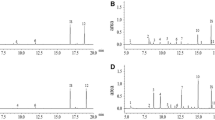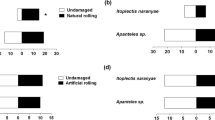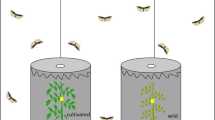Abstract
Transgenic soybean plants (RR) engineered to express resistance to glyphosate harbor a variant of the enzyme EPSPS (5-enolpyruvylshikimate-3-phosphate synthase) involved in the shikimic acid pathway, the biosynthetic route of three aromatic amino acids: phenylalanine, tyrosine, and tryptophan. The insertion of the variant enzyme CP4 EPSPS confers resistance to glyphosate. During the process of genetic engineering, unintended secondary effects are likely to occur. In the present study, we quantified volatile organic compounds (VOCs) emitted constitutively or induced in response to herbivory by the soybean looper Chrysodeixis includens in transgenic soybean and its isogenic (untransformed) line. Since herbivore-induced plant volatiles (HIPVs) are known to play a role in the recruitment of natural enemies, we assessed whether changes in VOC profiles alter the foraging behavior of the generalist endoparasitic larval parasitoid, Meteorus rubens in the transgenic line. Additionally, we assessed whether there was a difference in plant quality by measuring the weight gain of the soybean looper. In response to herbivory, several VOCs were induced in both the conventional and the transgenic line; however, larger quantities of a few compounds were emitted by transgenic plants. Meteorus rubens females were able to discriminate between the odors of undamaged and C. includens-damaged plants in both lines, but preferred the odors emitted by herbivore-damaged transgenic plants over those emitted by herbivore-damaged conventional soybean plants. No differences were observed in the weight gain of the soybean looper. Our results suggest that VOC-mediated tritrophic interactions in this model system are not negatively affected. However, as the preference of the wasps shifted towards damaged transgenic plants, the results also suggest that genetic modification affects that tritrophic interactions in multiple ways in this model system.



Similar content being viewed by others
References
Agrawal AA, Hastings AP, Patrick ET, Knight AC (2014) Specificity of herbivore-induced hormonal signaling and defensive traits in five closely related milkweeds (Asclepias spp. J Chem Ecol 40:717–729
Arimura G, Matsui K, Takabayashi J (2009) Chemical and molecular ecology of herbivore-induced plant volatiles: proximate factors and their ultimate functions. Plant Cell Physiol 50:911–923
Arruda MAZ, Azevedo RA, Barbosa HS, Mataveli LRV, Oliveira SR, Arruda SCC, Gratão PL (2013) Comparative studies involving transgenic and non-transgenic soybean: What is going on? In: Board J (ed) A comprehensive survey of international soybean research - Genetics, physiology, agronomyand nitrogen relationships. Intech press., Croácia, pp. 583–613
Bari R, Jones JD (2009) Role of plant hormones in plant defence responses. Plant Mol Biol 69:473–488
Brandão AR, Barbosa HS, Arruda MAZ (2010) Image analysis of two-dimensional gel electrophoresis for comparative proteomics of transgenic and non-transgenic soybean seeds. J Proteome 73:1433–1440
Bruce TJ, Wadhams LJ, Woodcock CM (2005) Insect host location: a volatile situation. Trends Plant Sci 10:269–274
Buchanan BB, Gruissem W, Jones RL (2000) Biochemistry and molecular biology of plants. American Society of Plant Physiologists. Rockville, Maryland
Bueno RCOF, Parra JRP, Bueno AF, Moscardi F, Oliveira JRG, Camillo MF (2007) Sem barreira. Rev Cultivar 93:12–15
Cheng KC, Beaulieu J, Iquira E, Belzile FJ, Fortin MG, Strömvik MV (2008) Effect of transgenes on global gene expression in soybean is within the natural range of variation of conventional cultivars. J Agric Food Chem 56:3057–3067
Clavijo McCormick AL, Unsicker S, Gershenzon J (2012) The specificity of herbivore-induced plant volatiles in attracting herbivore enemies. Trends Plant Sci 17:303–310
D’Alessandro M, Held M, Triponez Y, Turlings TC (2006) The role of indole and other shikimic acid derived maize volatiles in the attraction of two parasitic wasps. J Chem Ecol 32:2733–2748
De Boer JG, Dicke M (2004) The role of methyl salicylate in prey searching behavior of the predatory mite Phytoseiulus persimilis. J Chem Ecol 30:255–271
De Jong R, Kaiser L (1991) Odor learning by leptopilina boulardi a specialist parasitoid hymenoptera eucoilidae. J Insect Behav 4:743–750
Dean JM, De Moraes CM (2006) Effects of genetic modification on herbivore-induced volatiles from maize. J Chem Ecol 32:713–724
Dudareva N, Negre F, Nagegowda DA, Orlova I (2006) Plant volatiles: recent advances and future perspectives. Crit Rev Plant Sci 25:417–440
Erb M, Meldau S, Howe GA (2012) Role of phytohormones in insect-specific plant reactions. Trends Plant Sci 17:250–259
Erb M, Veyrat N, Robert CA, Xu H, Frey M, Ton J, Turlings TC (2015) Indole is an essential herbivore-induced volatile priming signal in maize. Nat Commun 6:6273
Fehr W, Caviness C, Burmood DT, Pennington JS (1971) Stage of development descriptions for soybeans, Glycine max (L.) Merrill. Crop Sci 11:929–931
Garcia-Villalba R, Leon C, Dinelli G, Segura-Carretero A, Fernandez-Gutierrez A, Garcia-Canas V (2008) Comparative metabolomic study of transgenic versus conventional soybean using capillary electrophoresis-time-of-flight mass spectrometry. J Chromatogr A 1195:164–173
Girling RD, Stewart-Jones A, Dherbecourt J, Staley JT, Wright DJ, Poppy GM (2011) Parasitoids select plants more heavily infested with their caterpillar hosts: a new approach to aid interpretation of plant headspace volatiles. Proc R Soc B 278:2646–2653
Hardy ICW, Griffiths NT, Godfray HC (1992) Clutch size in a parasitoid wasp: a manipulation experiment. J Anim Ecol 61:121–129
Hare JD (2011) Ecological role of volatiles produced by plants in response to damage by herbivorous insects. Annu Rev Entomol 56:161–180
Hermann KM, Weaver LM (1999) The shikimate pathway. Annu Rev Plant Physiol Plant Mol Biol 50:473–503
Hoffman Campo CB, Oliveira EB, Moscardi F (1985) Criação massal de lagarta da soja (Anticarsia gemmatalis). Embrapa CNPSo 23p
Horiuchi JI, Arimura GI, Ozawa R (2003) A comparison of the responses of Tetranychus urticae (Acari: Tetranychidae) and Phytoseiulus persimilis (Acari: Phytoseiidae) to volatiles emitted from lima bean leaves with different levels of damage made by T. urticae or Spodoptera exigua (Lepidoptera. Appl Entomol Zool 38:109–116
Kaplan I (2012) Trophic complexity and the adaptive value of damage-induced plant volatiles. PLoS Biol 10:e1001437
Kappers IF, Hoogerbrugge H, Bouwmeester HJ, Dicke M (2011) Variation in herbivory-induced volatiles among cucumber (Cucumis sativus L.) varieties has consequences for the attraction of carnivorous natural enemies. J Chem Ecol 37:150–160
Karban R, Baldwin IT (1997) Induced responses to herbivory. University of Chicago Press, Chicago
Loake G, Grant M (2007) Salicylic acid in plant defence—the players and protagonists. Curr op. Plant Biol 10:466–472
Maeda H, Dudareva N (2012) The shikimate pathway and aromatic amino acid biosynthesis in plants. Annu Rev Plant Biol 63:73–105
Mallinger RE, Hogg DB, Gratton C (2011) Methyl salicylate attracts natural enemies and reduces populations of soybean aphids (Hemiptera: Aphididae) in soybean agroecosystems. J Econ Entomol 104:115–124
Menzel TR, Weldegergis BT, David A, Boland W, Gols R, van Loon JJ, Dicke M (2014) Synergism in the effect of prior jasmonic acid application on herbivore-induced volatile emission by lima bean plants: transcription of a monoterpene synthase gene and volatile emission. J Exp Bot 65:4821–4831
Michereff MFF, Laumann RA, Borges M, Michereff-Filho M, Diniz IR, Neto ALF, Moraes MCB (2011) Volatiles mediating a plant-herbivore-natural enemy interaction in resistant and susceptible soybean cultivars. J Chem Ecol 37:273–285
Mithöfer A, Boland W (2012) Plant defense against herbivores: chemical aspects. Annu Rev Plant Biol 63:431–450
Moraes MCB, Laumann RA, Aquino MFS, Paula DP, Borges M (2011) Effect of Bt genetic engineering on indirect defense in cotton via a tritrophic interaction. Transgenic Res 20:99–107
Ngumbi E, Jordan M, Fadamiro H (2012) Comparison of associative learning of host-related plant volatiles in two parasitoids with different degrees of host specificity, Cotesia marginiventris and Microplitis croceipes. Chemoecology 22:207–215
Park SW, Kaimoyo E, Kumar D, Mosher S, Klessig DF (2007) Methyl salicylate is a critical mobile signal for plant systemic acquired resistance. Science 318:113–116
Parra JRP (2001) Técnicas de Criação de Insetos para Programas de Controle Biológico. FEALQ, Piracicaba
Pieterse CM, Van der Does D, Zamioudis C, Leon-Reyes A, Van Wees SC (2012) Hormonal modulation of plant immunity. Annu Rev Cell Dev Biol 28:489–521
Rostás M, Eggert K (2008) Ontogenetic and spatio-temporal patterns of induced volatiles in Glycine max in the light of the optimal defence hypothesis. Chemoecology 18:29–38
Shiojiri K, Ozawa R, Matsui K, Sabelis MW, Takabayashi J (2012) Intermittent exposure to traces of green leaf volatiles triggers a plant response. Sci Rep 2:378
Strapasson P, Pinto-Zevallos DM, Zarbin PHG (2016) Soybean (Glycine max) plants genetically modified to express resistance to glyphosate: can they modify airborne signals in tritrophic interactions? Chemoecology 26:7–14
Turlings TCJ, Ton J (2006) Exploiting scents of distress: the prospect of manipulating herbivore-induced plant odors to enhance the control of agricultural pests. Curr Opin Plant Biol 9:421–427
Turlings TCJ, Wäckers FL (2004) Recruitment of predators and parasitoids by herbivore-damaged plants. In: Cardé RT, Millar J (eds) advances in insect chemical ecology. University Press, Cambridge, pp. 21–75
Turlings TC, Jeanbourquin PM, Held M, Degen T (2005) Evaluating the induced-odour emission of a Bt maize and its attractiveness to parasitic wasps. Transgenic Res 14:807–816
Veyrat N, Robert CAM, Xu H, Frey M, Ton J, Turlings TCJ, Erb M (2016) Herbivore intoxication as a potential primary function of an inducible volatile plant signal. J Ecol 104:591–600
Vogler U, Rott AS, Gessler C, Dorn S (2010) Comparison between volatile emissions from transgenic apples and from two representative classically bred apple cultivars. Transgenic Res 19:77–89
Zarate SI, Kempema LA, Walling LL (2007) Silverleaf whitefly induces salicylic acid defenses and suppresses effectual jasmonic acid defenses. Plant Physiol 143:866–875
Zonetti PC, Suzuki LS, Bonini EA, Ferrarese MLC, Ferrarese-Filho O (2012) High temperatures on root growth and lignifications of transgenic-resistant soybean. Agrociencia 46:557–565
Acknowledgments
The authors thank Dr. Marco Antonio Root de Oliveira and Mrs. Franciele Bebber from COODETEC-Cascavel who provided us with the seed material; Dr. Eduardo Shimbori (Universidade Federal de São Carlos) and Dr. Helmuth Aguirre (University of Wyoming, Laramie) for identification of M. rubens; Prof. Leandro S. Souto for support in the statistical analyses, and Profs. Jeffrey Aldrich and Martin Pareja for improving the draft version of the manuscript. Conselho Nacional de Desenvolvimento Científico e Tecnológico CNPq Processo N° 401928/2012-8, Coordenacão de Pessoal de Aperfeiçoamento de Nível Superior (CAPES), and Instituto Nacional de Ciências e Tecnologia de Semioquímicos na Agricultura (INCT) are acknowledged for financial support.
Author information
Authors and Affiliations
Corresponding author
Rights and permissions
About this article
Cite this article
Strapasson, P., Pinto-Zevallos, D.M., Da Silva Gomes, S.M. et al. Volatile Organic Compounds Induced by Herbivory of the Soybean Looper Chrysodeixis includens in Transgenic Glyphosate-Resistant Soybean and the Behavioral Effect on the Parasitoid, Meteorus rubens . J Chem Ecol 42, 806–813 (2016). https://doi.org/10.1007/s10886-016-0740-9
Received:
Revised:
Accepted:
Published:
Issue Date:
DOI: https://doi.org/10.1007/s10886-016-0740-9




